A Museum in a Book:
Teaching Culture through Decolonizing, Arts-based Methodologies
Sharon Verner Chappell
Drew Chappell
California State University Fullerton, U.S.A.
Citation: Chappell, S. V., & Chappell, D. (2011). A Museum in a Book: Teaching Culture through Decolonizing, Arts-based Methodologies. International Journal of
Education & the Arts, 12(LAI 1). Retrieved [date] from http://www.ijea.org/v12lai1/.
Abstract
This paper explores the positivist, museum-based, and touristic constructions of indigenous cultures in the
Americas, as represented in the DK Eyewitness series, and then overturns these constructions using an
artist book created by the authors. In our analysis of the nonfiction series, we identified three
trajectories: cataloguing, consignment to the past, and pleasurable display. Using techniques
borrowed from "new historiography" and the decolonizing methodologies of Linda Tuhiwai Smith (1999),
we suggest ways in which adults and young people might "speak back" to these positivist paradigms.
Visual Abstract

Introduction
Recently, our family visited the La Habra Children's Museum in La Habra, California.
Traveling down a series of corridors, past a space exhibit and an electric train set, we reached a
room labeled "Nanny's Travels." A cabinet of curiosities housing "multicultural" artifacts donated
to the museum, the exhibit simulates a grandmother's collection of objects from her travels, and
constructs a tourist's world view. "Nanny's Travels" is organized by geographic region and contains
masks, prints, and objects for guests to handle, as well as other artifacts shelved behind glass doors.
While we looked around the room, two grade school girls tried on kimonos. Their father exclaimed, "You
look like geishas!" One girl took off her robe, tossed it back in a basket on the floor, and announced:
"There must be more to the museum than this."
When introducing history to young people, in order to create a material link with the past, teachers
often rely on historical artifacts housed in museums, reproductions of these artifacts in textbooks
and reference materials, as well as real or simulated cultural objects for young people to encounter,
as in the "Nanny's Travels" exhibit described above. Through contact with these cultural traces, students
gain a vocabulary for and story of the past, making concrete abstract notions of historical people and
places. In this paper, we investigate the positivist, colonial, and touristic underpinnings of such an
exhibitionary approach to understanding cultures in their past and present incarnations, as represented
in a popular reference series by the publisher Dorling Kindersley (DK). We juxtapose this analysis with
images from an artist book we created in response to the series and its pedagogical strategies; we hope
this book will raise questions about how readers might speak back to and problematize the constructions
of cultural knowledge about self and Other presented in such "authoritative" texts for young people.

Before describing our project, we wish to recognize our problematic subject positions as two White,
middle class university researchers interested in the ways that popular Western texts understand
indigenous peoples, historically and today. We are conscious of our backgrounds as representatives
of the institution that historically contributed to the colonial project; and, we hope to undertake
methods of analysis that decolonize this set of practices. Colonialized research contained, objectified,
and physically scarred groups of non-White peoples across the world for centuries. Such research included
measuring native bodies, displaying native peoples in medical and entertainment settings, preserving
their remains, and stealing their tools and resources for university or museum use. As Linda Tuhiwai
Smith (1999), a Ngati Awa and Ngati Porou activist and researcher from New Zealand, writes, "The word
itself, 'research,' is probably one of the dirtiest words in the indigenous world's vocabulary" (p. 1).
Through the research described in this paper, we hope to create counternarratives about the purposes of
research in university and popular education settings for use with, for and by young people.
Yet, we recognize the inherent problems in conducting such a study: can we as non-indigenous people talk
back to colonizing research? Even if we can construct new narratives that problematize the history of
Western imperialism, how might our research still further colonial projects, and how can we be aware of
the scripts that we maintain rather than work to dismantle? We address these questions explicitly
throughout this paper, and have insisted on self-reflexivity throughout our research process. This
reflexivity included a constant re-examination of claims and assumptions we were making, as well as
positioning ourselves within critical race discourses (JanMohammed, 1985; Ladson-Billings & Tate, 1994;
Tuhiwai Smith, 1999).
For our project, we analyzed two texts from a popular non-fiction visual encyclopedia series for youth
called the DK Eyewitness series. In Aztec, Inca and Maya (Baquedano, 2005) and
North American Indian (Murdoch, 2005), we identified three trajectories for analysis: 1)
the ways the books catalog (collect, order, and label) ethnographic objects, 2) the ways the
books construct notions of "progress," in relation to consigning these cultures and people to the past,
and 3) the ways that display and pleasure interact with the readers' gaze in this storytelling.
We argue that these trajectories relate to a broader positivist and colonial epistemology utilized
in museums in order to construct and perform the identity development of Western individuals and
nations. Such an epistemology, when presented in a non fiction book for young people, constitutes an
instance of what Chappell (2010) has termed "colonizing the imaginary," an "ideological process in
which adults write their own culturally-bound values, beliefs and ideas onto narrative structures and
performances intended for children's consumption" (p. 11).
DK and The Eyewitness Series
The publisher Dorling Kindersley (DK) aims to expose readers to various subject matter--including history--
through the foregrounding of visual content. The company has built itself on this formula, and hails the
books' success on its website:
DK's children's reference titles are second to none. The list covers a vast range of
children's interests for every age group - dinosaurs, space, nature, history, religion,
sport and science. In addition the publishing also includes a number of richly
illustrated and highly accessible encyclopedias for learners of every age (DK site,
Company Overview).
The Eyewitness Books series was one of the company's earliest offerings. Since 1987, these illustrated
guides have formed the core of DK's children's reference booklist, covering a range of topics but often
focusing on world history and culture. Guides in this vein include: Africa; American Revolution; Ancient
China, Ancient Egypt, Ancient Greece, and Ancient Rome; Bible Lands; Explorer; Leonardo [DaVinci]
and His Times; Medieval Life; Prehistoric Life; Presidents; Russia; Viking; Wild West; and
World War I and II. DK recognizes that it owes its success largely to this series, and its
"unique lexigraphic design, an explanatory combination of words and pictures" (DK site, About
Us/Children's Books). From our observation as parents, teachers, and childhood studies scholars,
the Eyewitness Series has a far reach, appearing in many school and public libraries and bookstores.
The books establish a common foundation for children's learning about subject matter in the sciences and
social sciences.
The series' name, "Eyewitness," implies immediacy, a coexistence--albeit brief--with the culture that
produced the artifacts. The wording hints at time travel, at adventure, at the reader's presence during
exciting and influential events. Just as museums want to persuade their patrons that there is a simultaneity
between contemporary and historical within a bounded space--performing a psychological erasure of the
glass cases and velvet ropes that demarcate a museum's displays--the Eyewitness series conjures an e
xperience out of photographs and captions. It wants to involve young readers in what Baudrillard (1994)
calls the hyperreal, to sell the impossible and disguise learning.
In this way, DK's approach differs from traditional reference material publishers,
which would likely not promote themselves as leisure reading. Eyewitness books emphasize "fun,"
from their foregrounding of unfamiliar (to a contemporary middle class US child) artifacts to their use
of bright colors in the titles. The book covers promise glimpses into other cultures, as opposed to a
series of facts. They imply that the reader will meet historical personages, see events firsthand, and
have fascinating experiences. In this regard, they are using stylistic devices reminiscent of graphic
novels to teach through entertainment. This simulation of travel and encounter depends on what DK calls
its "unique lexigraphic design" (DK site, About Us/Children's Books). Photographs and other reproductions
of artifacts dominate the pages, so that the reader encounters primary sources preserved across time and
space. These artifacts are interpreted with titles and textual explanations and grouped according to
various organizational strategies such as theme or geography.
We are interested in the ways that viewers read multiple meanings into the photographs of these
indigenous artifacts. Images are ambiguous and produce a surplus of meaning, even when they are
presented as artifacts of a culture's "true past." The maker of an image cannot control its connotations,
which are dependent on both the viewer's and the image-maker's subject positions. Thus, Barthes' (1977)
theory of denoted and connoted meaning is important: "In short, all these 'imitative' arts comprise two
messages: a denoted message, which is the analogon itself, and a connoted message,
which is the manner in which the society to a certain extent communicates what it thinks of it" (p. 17).
For example, in North American Indian, an image of a headdress may denote the artifact
itself, but connote a series of (non-native) cultural constructions of that headdress, informed by old
Western films, sports mascots, and even "cigar store Indians." Therefore, as we created our own artist
book about how children's texts construct indigenous people's stories and cultures, we wanted to engage
the potential of this ambiguity and the contradictions that arise when we consider the multiple subject
positions (informed by enculturation) of the potential viewers of art objects.
Barthes (1977) was also concerned with the relationship of photographs to text. He argued that
an image is more precise than a textual description. Text imposes an interpretation, attempting to
control the image's connotation. If the artifact or image is available, Barthes suggested, it should
stand on its own, or with limited description. When the opposite strategy--one of captioning text--is
employed, Barthes wrote: "[I]t is not the image which comes to elucidate or 'realize' the text, but the
latter which comes to sublimate, patheticize or rationalize the image" (p. 25). For Barthes, such
captioning of images--the fundamental strategy of the Eyewitness series--is negative and misleading.
Even proximity makes a difference: "The closer the text to the image, the less it seems to connote it;
caught as it were in the iconographic message, the verbal message seems to share in its objectivity,
the connotation of language is 'innocented' through the photograph's denotation" (p. 26). Although
Barthes does not posit the photograph itself as lacking in subjectivity, he is specifically concerned
with how the reader can be drawn in by captioning.
When teaching children to read images, Freedman (2003) suggests building on Barthes' denotation/connotation
binary. Disregarding text, she formulates three steps in the interpretation of an image:
Lower-level interpretive skills include the discernment of a simple, intended message
of a symbolic representation or personalizing a situation that one sees represented.
Higher-level interpretive skills include: (1) unpacking underlying assumptions; (2)
forming multiple, possible associations; and (3) performing self-conscious, critical
reflection (pp. 87-8).
Through this approach, Freedman introduces the concepts of subjectivity in constructing the image,
surplus of meaning, and the effect of situated identity. She sees the ambiguity inherent in the use of
image, and knows that this ambiguity is important to bring to children's consciousness, lest they take
images at face value and depend on common, uninterrogated, even harmful assumptions.
When analyzing the Eyewitness series, our guiding questions were: how are the books constructed?
What messages do they convey? How do we subjectively understand them? And, what are the pedagogical and
cultural implications of displaying artifacts and constructing knowledge in a way that parallels a
traditional museum experience, with icons (photos or artifacts), indexes (explanatory text), and symbols
(frames, pointers, glass cases)? We respond to these questions through the construction and display of
an artist book.
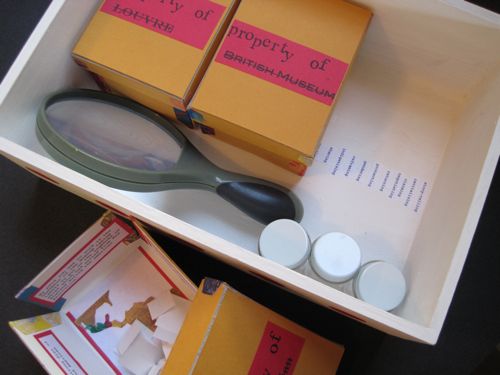
Museums and The Colonial Idea(l)
For this project, we were interested in the ways that curatorial practices from anthropology and art history, developed during the European Enlightenment, have often influenced educational curricula, whether in books, museums, or on guided tours. While not all museums shared the same goals, many display practices were influenced by methods of collecting, storing and exhibiting cultural objects dating back to Linneaus' 18th century methods of classifying natural materials. Woodhead and Stansfield (1994) suggest that these collection and display practices, when applied to sociocultural phenomena, explicitly contemplated the meaning of cultural heritage and constructed an understanding of the world relating the (Western) viewer's identity to that of Others.
Such naturalistic methods were applied to the study of bodies and sociocultural practices of native peoples encountered and subjugated by Western powers during the colonial projects of the 19th and 20th centuries. These practices have been well documented by researchers such as Michael Taussig (1987), who writes: "...in the book said to be [Eugene] Robuchon's there are many photographs of naked Indian women, scientific-anthropological mugshots with an anterior view, a posterior view, and an accompanying dissecting text" (pp. 112-113). The episteme of positivism, developed by Auguste Comte (1957), exemplified and "justified" such study, which still persists in publications from the Smithsonian and National Geographic. Early modes of display established hierarchical categorizations of people based on race, which framed the exoticization and subjugation of non-white races. The voice of the curator was used to present "expert" views on cultures in order to manage and control difference (Kirshenblatt-Gimblett, 1998 & 2006; Kratz & Karp, 2006). These practices led to the construction of non-White civilizations as static and "primitive," or in a state of "arrested" development before the modern era (Bennett, 2006).
In the last twenty years, a "new" museology has responded to postcolonial criticism and the impact of globalization on local and indigenous communities, embracing the roles various publics should have in the construction and interpretation of ethnographic displays (Szwaja & Ybarra-Frausto, 2006) has responded to postcolonial criticism, acknowledging the impact of globalization on local and indigenous communities. Museum administrators and researchers have begun to consider museums as zones of contact for diverse publics (Clifford, 1999). The emphasis on objects has shifted to an emphasis on people, and how they encounter museums and museum knowledge from different perspectives, values and beliefs (Kratz & Karp, 2006). Others began to think about how museum affect communities beyond the physical space of exhibition itself, such as how the institution might contribute to community cultural development and the "transnational imaginary" about migrant and indigenous populations (Szwaja & Ybarra-Frausto, 2006). Indigenous community museums, museums of consciousness, and oral history exhibitions are examples of such response. Revised curatorial practices also developed, such as making visible different agendas in the act of ethnographic display and opening the museum to public dialog, including contestation and collaboration (Kratz & Karp, 2006; Kirshenblatt-Gimblett, 2006).
Important to us is how these new curatorial practices make visible what Bennett (2006) calls the "logic of culture" in Western identity development and knowledge construction. As museum visitors look at displays of Other cultures, they are engaging in "a process of critique through which the individual extricates him or herself from unthinking immersion in inherited traditions in order to initiate a process of self-development that will result in new codes of behavior" (p. 53). In a colonial logic of culture, museums displayed the objects on non-White civilizations as "immobilized remnants of redundant pasts" (Bennett, 2006, p. 55). In this sense, the development of White, male and upper class identities required the fixing of marginalized identities and cultures.
In contemporary new museology curatorial practices, museums have responded to a positivist "logic of culture" by including the voices of people previously ignored in the curatorial process, promoting intercultural dialog among visitors, and moving away from a seamless presentation of history (normal history) to narratives that focus on rupture, conflict, discontinuity and displacement (effective history), (Hooper-Greenhill, 1992). One example is installation artist Kara Walker's silhouette murals that analyze constructions of history around issues of race, such as her 1997 work,
Slavery! Slavery! Presenting a GRAND and LIFELIKE Panoramic Journey into
Picturesque South Slavery of "Life at 'Ol' Virginny's Hole' (sketches from Plantation
Life)." See the Peculiar Institution as never before! All cut from black paper by the
able hand of Kara Elizabeth Walker an Emancipated Negress and leader of her Cause
1997.
Her murals ask the audience to engage a relationship between the seamless narrative of slavery to emancipation with the effective history of on-going conflict, discrimination, and oppression of African American people through the legacy of slavery. We are challenged to contribute to such a production of disruptive, conflicting history-telling in order to raise questions about how material artifacts contribute to young people's knowledge construction of Others.
Artist Book as Decolonizing Method: Responding through Artmaking
The more we looked at the Eyewitness books (Aztec, Inca, and Maya and North American Indian), the more we wanted to talk about the practices of constructing knowledge through authoritative texts and institutions--such as non-fiction resource books and museums--rather than conduct a strict discourse analysis of the Eyewitness books themselves. We decided to use the construction of a collaged artist book to explore how knowledge is constructed through re-experiences rather than paradigmatic explanations (Barone, 2001; Cahnmann & Siegesmund, 2008; Knowles & Cole, 2007). Arts-based research allows for an alternative means of both data analysis and textual presentation that asks the reader to encounter a phenomenon through sensory means, experience it anew, and become unsettled in order to destabilize common place assumptions about that issue. Following Barthes' discussion of the open-ended quality of images, arts-based methods are interested in the embodied responses of researchers and readers, as well as the pursuit of questions rather than certain, "truthful" conclusions about the phenomenon (Barone, 2001; Springgay, 2008). These approaches contrast with traditional patterns of curatorial choices made in the construction of an exhibition (or exhibitionary display).
In this case, we have chosen to analyze our data through the construction and display of an artist book that utilizes book arts, collage and performance-based methods. The field of book arts is interested in the function of the book as an object and medium for audience interaction (Bodman, 2008; Judd & Hubert, 1997; Rothenberg & Clay, 2000). The structure of the book, as well as the artistic elements inside inform the meaning that audiences construct as they physically manipulate these books. These books "demand touching" (Smith, 2000, p. 60). Unlike traditionally printed and mass-merchandised books, artist books are interested in experimenting with aesthetic forms, structures, materials and content in order to invoke and produce particular sensory, ethical and cognitive experiences in the reader. Further, book artists are involved in the entirety of the production process, so that as a research method, all of the choices in production become symbolic or in some way reflective of the data being analyzed.
The aesthetic choices in our artist book are informed by collage and performance-based methods. Vaughn (2005) and Chappell (2009) both discuss how collage is a borderlands epistemology for understanding social and cultural phenomena. Collage involves the juxtaposition and layering of objects and materials according to particular aesthetic elements and principles rendered in both visual and literary arts. By relating different materials together, collage involves hiding and revealing, emphasizing and deemphasizing. The materiality of the artist book raises questions about ways that different texts interact in the interpretation of material culture, a technique of particular importance when understanding historical objects interpreted in contemporary contexts (Starbuck, 2003).
We are also informed by the interactive and political qualities of borderlands performance artists such
as Guillermo Gomez-Pena (2005), who says, "when we create objects, they are meant to be handled and
utilized without remorse during the performance" (p. 22). His performance art utilizes the strategy
of "reverse anthropology: pushing the dominant culture to the margins and treating it as exotic and
unfamiliar" (p. 25). For example, at museums and cultural centers around the world, Gomez-Pena and
Coco Fusco performed an installation called "Two Undiscovered Amerindians Visit the Americas"
(popularly known as The Couple in the Cage due to the documentary by Fusco and Heredia, 1993). Gomez-Pena and Fusco performed pseudo cultural rituals of an invented indigenous culture and asked the audience to interact with them through the cage. Unlike traditional plays that adhere to a script and employ a bounded space between the audience and actors, this performance art confronts the idea of border construction through interaction not only with the performance but also with the objects that mediate the performance and the audience's construction of knowledge about the objects of that performance. It is quite possible, for example, for visitors to think that the "undiscovered Amerindians" are actually indigenous people, based on their own cultural reading of the performance.
In our artist book, we used interactive elements in both the book construction and its content in order to heighten the reader's awareness about objectivity and subjectivity related to interpreting displays of indigenous peoples of the Americas. In the book, we included select quotations from Linda Tuhiwai Smith's book, Decolonizing Methodologies: Research and Indigenous Peoples (1999), as she speaks directly to the colonizing process of Western research itself:
At a common sense level research was talked about both in terms of its absolute worthlessness to us, the indigenous world, and its absolute usefulness to those who wielded it as an instrument. It told us things already known, suggested things that would not work, and made careers for people who already had jobs (p. 2).
Her voice is a felt presence that haunted us in our writing and our book construction: how could we as
researchers comment on the colonizing history of Research as a purpose and mode of conducting research
ourselves? And, are we in action and consequence inescapably participating in such a history? We
intended for both the structural elements of the book and its content to build layers of
counternarrative to the curatorial practices utilized by the Eyewitness series. We also felt that the inclusion of one consistent indigenous voice whose context we could illuminate with respect and detail would provide a perspective that is visibly absent in the nonfiction DK texts. The Eyewitness series allows little room for reader-centered interpretation of objects or narrative about the historical context surrounding the objects. Our challenge was to raise questions about positivist research paradigms and their relationship to cultural commodification, since to us, the Eyewitness series functions as both.
The artist book is contained in a wooden filing box labeled: "Museum in a Book. Chappell and Chappell, 2010." Within this box are three smaller boxes, a magnifying glass, and three collection jars. When the first box is opened, its sides fall apart revealing six "people" (dolls) pinned to the sides like insects collected and labeled by an early naturalist. Unpinning the people and removing them from their collection context reveals text on their backs, quoted from Linda Tuhiwai Smith, relating to concerns of tribal members and researchers about the distribution of the collective memory of imperialism displayed by Western people to themselves and back to indigenous people as well (1999, pp. 1-2).
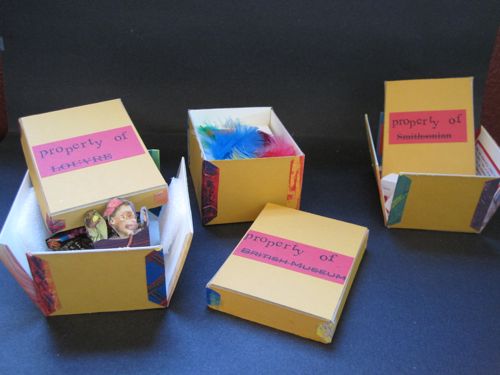
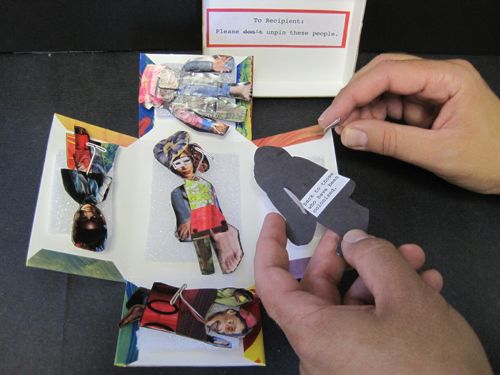 In the second box is a collection of feathers, and underneath these is a sorting tray where the feathers
may be placed. At the base of each box in the sorter is more text inspired by Tuhiwai Smith's critique of
the West's economic and cultural dependence on trading the Other as a means of knowledge formation and
distribution (p. 89). The lid contains a list of feathers and their historical function, as expressed in
North American Indian and Aztec, Inca and Maya.
In the second box is a collection of feathers, and underneath these is a sorting tray where the feathers
may be placed. At the base of each box in the sorter is more text inspired by Tuhiwai Smith's critique of
the West's economic and cultural dependence on trading the Other as a means of knowledge formation and
distribution (p. 89). The lid contains a list of feathers and their historical function, as expressed in
North American Indian and Aztec, Inca and Maya.
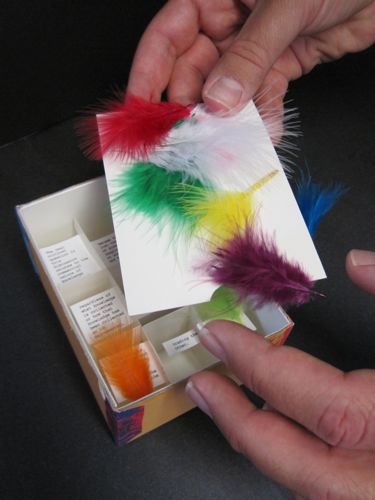
When the third box is opened, its sides fall apart, as with the first box, and a group of cards, or labels, fall out. On the lid and base of the box are two geographic maps of the Americas, modified from those included in the Eyewitness series. The cards contain both phrases from the series about the land and beliefs of the people as expressed by the authorial/curatorial voice. The collapsed sides of the box contain a quote from Tuhiwai Smith, this time focusing on issues of place and her relationship to museum practices.
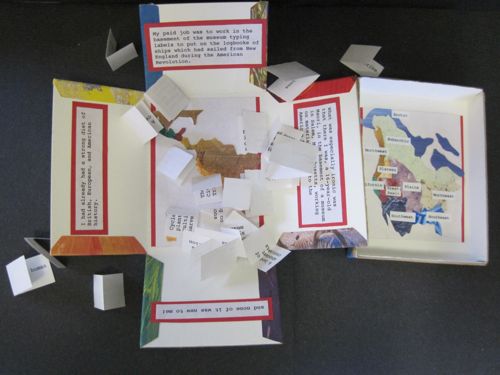
Below is a more detailed discussion of the content of our artist book, as we see it through the three epistemological tropes we identified earlier: cataloguing (collecting, ordering, and labeling); "progress" and the consignment of indigenous cultures to the past; and the interaction of the display and the gaze as a politics of pleasure.
Cataloguing: Collecting, Ordering, and Labeling
As part of the positivist/colonial project, scientists and anthropologists engaged in cataloguing the natural world. When they encountered indigenous societies, their impulse was to treat these people in the same manner as animals or plants; that is, to "study" them with an eye toward defining their differences and establishing mastery over them through knowledge. Tuhiwai Smith (1999) writes:
It appalls us that the West can desire, extract, and claim ownership of our ways of knowing, our imagery, the things we create and produce, and then simultaneously reject the people who created and developed those ideas and seek to deny them further opportunities to be creators of their own culture and own nations. (p. 1)
Such a methodology might be defined as "cataloguing;" building definitions of objects (or people) under study through collecting, ordering, and labeling. These "objects" might be collected through archeological extraction, sale, trade, or theft. They might be everyday tools such as bowls, knives, or dolls; works of art; items with religious significance such as masks or staffs; or even the remains of people themselves.
Yet, how are we to view these traces of the past? Kirshenblatt-Gimblett (1998) writes: "...I want to suggest that ethnographic objects are made, not found, despite claims to the contrary. They did not begin their lives as ethnographic objects. They became ethnographic through processes of detachment and contextualization" (p. 3). Traditionally, this detachment has been part of a strategy of purported objective, rational study; and yet, we have seen how such a strategy affected and continued to affect indigenous people.
Performance studies scholar Diana Taylor (2003) establishes two ways of knowing about the past, which she terms "archive" and "repertoire":
"Archival" memory exists as documents, maps, literary texts, letters, archaeological
remains, bones, videos, films, CDs, all those items supposedly resistant to change. . . .
The repertoire, on the other hand, enacts embodied memory: performances, gestures,
orality, movement, dance, singing--in short, all those acts usually thought of as
ephemeral, nonreproducible knowledge (pp. 19-20).
Taylor points out that traditionally historians have relied on tangible, archival sources to learn about the past, as these are theoretically not subject to change or impacted by subjectivity or human memory. The artifacts in the Eyewitness series bear out this traditional notion; the publishers clearly rely on physical historical traces--such as jewelry, tools, and pottery--as a foundation for learning culture. Traces from the repertoire of the cultures focused on in the books are for all intents and purposes, absent. The books consist of archival reproductions and contemporary framing, description, and interpretation of those reproductions.
This artifact-based cataloguing strategy is paramount in the Eyewitness books. Chapters are broken up by region or topic: Cities of the Andes, The Spanish Conquest, War and Peace, Land of the Totem Poles. Yet, this strategy is not limited to the Eyewitness books and museum spaces such as Nanny's Travels mentioned at the beginning of the article. Cataloging, ordering and labeling exist in travel brochures, non-fiction films for young people, and guided tours, among other spaces. In order to trouble this specific trajectory, we built the following "encounters" into our artist book.
-
The dolls pinned to the sides of a box raise questions about the physical and metaphoric deaths occurring through the collection of indigenous peoples and their cultural traces. Tuhiwai Smith's voice on the back of the dolls challenges Eyewitness' emphasis on artifacts as the primary way of "knowing" past and present stories of indigenous peoples and the impact of Western research on their lives. Further, the act of unpinning the people in order to access their voices raises questions about the role of the viewer in complying with objectifying methods of understanding Others in a curatorial setting.
-
A collection of labels spill out of a box with two maps, one of the cultural regions of American Indians and the other of the geographic regions of the Aztec, Inca and Maya. The maps in this box are in an abstract style to highlight the tension between rationalism and storytelling and magic in geographic categorizing of people. The labels do not have indication of their numerical order or proper location on the maps, and contain language from the Eyewitness books that seek to define the cultures under study. When paired with Tuhiwai Smith's voice on the sides of the box, these disordered labels and maps raise questions about both the expertise and ethics of the curatorial voice in categorizing peoples, and the role of the viewer in constructing narratives through the texts given to them. For example, one label reads, "art second to none." We invite the viewer to wonder, "Whose art?" "Who decides on its excellence?" "Why is the ranking of this art work important to our understanding of a group of indigenous peoples?"
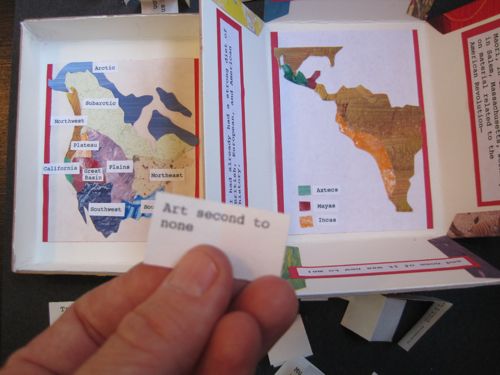
- In a third box, feathers are listed by their location on various cultural artifacts as identified in the Eyewitness books, such as, "Feather from Inuit woman's finger mask." The box claims that the feathers are authentic artifacts while obviously being manufactured (bright colors, in newly-made condition). If the viewer lifts the floor holding the feathers, s/he will find a sorting box with Tuhiwai Smith's criticisms of "trading the Other." The quote is segmented and suspended in sections of the sorter. If the viewer would like to sort the feathers into their boxes, s/he would have to push through Tuhiwai Smith's voice, potentially bending the paper her quote is written on in order to make the feathers fit. This raises questions about the ethics of gathering cultural objects for categorizing and display, as well as the role of the viewer in consuming this sorting and segmenting of people.
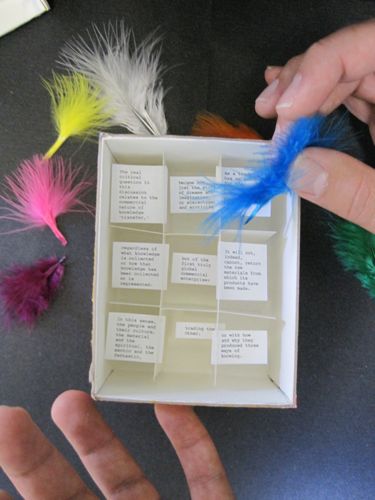 We hope these encounters call attention to the effects of an ongoing cataloguing of native peoples, in a way consistent with Kirshenblatt-Gimblett's (1998) appreciation of the performances she witnessed at the 1990 Los Angeles Festival: "A mode of reception in which confusion is pleasurable opens up possibilities for the exhibition of African art, while keeping alive the issue of what can and cannot be shown or known" (p. 11). In our implications, we expand on how young people themselves can destabilize the constructed expertise of the curatorial voice in order to understand the impact of Western collection from multiple perspectives (particularly those of indigenous people affected by such "research").
We hope these encounters call attention to the effects of an ongoing cataloguing of native peoples, in a way consistent with Kirshenblatt-Gimblett's (1998) appreciation of the performances she witnessed at the 1990 Los Angeles Festival: "A mode of reception in which confusion is pleasurable opens up possibilities for the exhibition of African art, while keeping alive the issue of what can and cannot be shown or known" (p. 11). In our implications, we expand on how young people themselves can destabilize the constructed expertise of the curatorial voice in order to understand the impact of Western collection from multiple perspectives (particularly those of indigenous people affected by such "research").
"Progress" and Consignment of Cultures to the Past
The "veneration of artifact" described above also concerned sociologist Jean Baudrillard (1994): "In order for ethnology to live, its object must die; by dying, the object takes its revenge for being 'discovered,' and with its death defies the science that wants to grasp it. . . . Like Orpheus, it [the science] always turns around too soon, and, like Eurydice, its object falls back into Hades" (p. 7). For Baudrillard, the more researchers depend on the archive, the more they lose sight of the culture that produced it, consigning it to history.
Baudrillard (1994) also warns of the essentialization inherent in holding up pieces of the archive as representative of a culture: "The Indian thus returned to the ghetto, in the glass coffin of the virgin forest, again becomes the model of simulation of all the possible Indians from before ethnology" (p. 8). He posits that looking at artifacts benefits humans as collectors, but not researchers: "Ramses does not signify anything for us, only the mummy is of an inestimable worth because it is what guarantees that accumulation has meaning. Our entire linear and accumulative culture collapses if we cannot stockpile the past in plain view" (pp. 9-10). Baudrillard points out that through their survival and subsequent restoration, artifacts are indeed changed and pushed toward the hyperreal:
Everywhere we live in a universe strangely similar to the original--things are doubled
by their own scenario. But this doubling does not signify, as it did traditionally, the imminence of their death--they are already purged of their death, and better than when they were alive; more cheerful, more authentic, in the light of their model, like the faces in funeral homes (p. 11).
Here he points to the positivist/colonial process of consigning certain cultures to history, of creating a "heritage" or "folklore" from once dominant civilizations forced to the margins by the (enacted) Western conceit of "progress."
Kirshenblatt-Gimblett (1998) writes: "The processes whereby errors become anachronisms, objects become ethnographic, and ways of life become heritage test the alienability of what was found at the source. They also test the limits, even the violations, of a second life as heritage, particularly in the presence of the not yet dead" (pp. 8-9). In the case of Native American relations, this idea has further resonance. Social critic DH Lawrence (1924), struggling to understand US American expansion, wrote: "No place exerts its full influence over a newcomer until the old inhabitant is dead or absorbed" (p. 40). Historian Philip Deloria (1998) follows these chilling words with: "These have, in fact, been two familiar options in the history of Indian-American relations, both aimed at making Indians vanish from the landscape" (p. 4). Of course, native peoples--across the Americas--have not vanished; their cultures persist in the face of ongoing cultural and political assault. Thus consigning their existence to the past erases present injustices and inequality.
The Eyewitness series' strategy of using the visual artifact/textual caption
structure participates in consigning these societies to history instead of addressing
their current situation. The books discuss indigenous groups almost exclusively using
past tense and covering historical events, with only a two-page section in North
American Indian called "Modern Times." Here the authors point to the rich
contemporary life of indigenous people, acknowledging, "The 'vanishing Indian' was
how Native North Americans were regarded a century ago. They were expected eventually
to join white society or simply die out, but they have refused to do either" (Murdoch,
2005, p. 62). We appreciate this section, yet we wish the authors had woven this
discussion throughout the book. There is no mention of the contemporary people whose
ancestors are Aztec, Inca or Maya. Both North American Indian and Aztec, Inca,
and Maya include two page sections called "find out more" which suggests ways in
which young people can perform research or visit pre-Columbian sites where these people
lived. The section begins: "The cultures of the Aztec, Inca, and Maya may have
disappeared, but the wealth of relics and ruins left behind reveal much about these
ancient people and their times" (Baquedano, 2005, p. 68). A caption next to a group of
musicians reads: "Today, folk musicians keep the sounds of the past alive, performing
traditional music on modern replicas of instruments used by Aztec, Inca, and Maya
musicians" (p. 68). Presenting indigenous American cultures in this way highlights the
museum/touristic nature of the books, and keeps the societies in an arrested state of
development.
In background research for our artist book, we found multiple sources of contemporary indigenous people's experiences, even other DK series like Children Just Like Me (Kindersley & Kindersley, 1995) and A Life Like Mine (DK Publisher, 2005). Yet, the Eyewitness series chose to exclude any of their perspectives as primary source quotes or stories. We wanted the artist book to trouble the notions of who constructs cultural progress and consigning particular peoples to the past. We constructed the following encounters:
-
When the viewer first handles the wooden box containing all the small boxes, s/he will see simulated "air holes" along the outside walls suggesting there are "living things" inside. These holes are red, raising the question: are they breathing or bleeding? After taking the smaller boxes out to handle them, the viewer will see a series of words stacked on each other on the floor of the wooden box, simulating a spinal column. The words are the titles of twenty four indigenous research projects that Tuhiwai Smith (1999) describes in her book.


-
In one of the smaller boxes, the dolls are made by collaging photographs of contemporary--not just indigenous-- people selected from the current National Geographic and National Geographic Traveler magazines. The body parts are deliberately out of proportion, the body parts and skin tones mismatched, the clothing styles and physical actions of the bodies inconsistent. Here, we wanted to raise questions about the Eyewitness construction of indigenous cultures using a seamless, historical narrative in which cultural groups are primarily isolated from contemporary global interconnectedness. We wanted the viewer to wonder about how globalization has impacted our understanding of imperialism as both a force of the past and present in various people's lives.
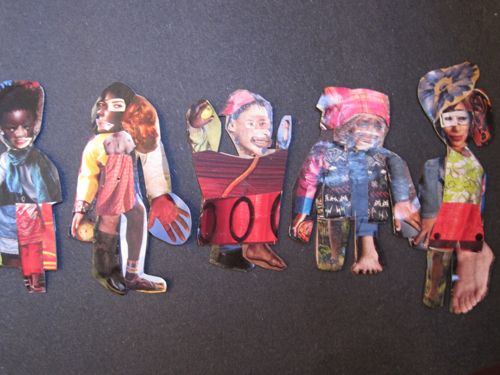 Knowing through the Gaze: "Learning," Display, and the Politics of Pleasure
Knowing through the Gaze: "Learning," Display, and the Politics of Pleasure
In museums, on tours, and in the Eyewitness series, artifacts do not speak for themselves. They are framed, displayed in particular ways in order to make an author/curator/teacher/tour guide's point. Recall Barthes' mistrust of such connotative speech, his insistence that the objects themselves are changed through such interpretation. Kirshenblatt-Gimblett (1998) expands on this point:
When the value of such things has little to do with their appearance, showing them--asking that one look at them--unsettles the certainty that visual interest is a prerequisite for display. The very absence of visual interest (in a conventional sense) points to ways that interest of any kind is created and vested. Particular kinds of interest not only guide the fragmentation and collection of the world and its deposit in museums, but also endow those fragments with their autonomy as artifacts (p. 2).
And what of reproductions of artifacts, including photographs? Benjamin (1939/2003) identifies the trouble inherent in removing an artifact from its lived context:
In even the most perfect reproduction, one thing is lacking: the here and now of the work of
art-its unique existence in a particular place. It is this unique existence-and nothing else-that bears
the mark of the history to which the work has been subject (p. 253).
Benjamin goes on to describe the intangible connection of artifact to cultural context, calling this
connection an "aura." The aura may persist in the cultural artifact, but it disappears when that
artifact is reproduced: "By replicating the work many times over, it [the technology of reproduction]
substitutes a mass existence for a unique existence" (p. 254). Here, Benjamin is primarily concerned with the tension in claiming authenticity and certainty, particularly in the decontextualization and loss of "life" through reproduction.
In the Eyewitness series, every page is white, foregrounding the artifacts and making them the emphasis of discussion. This style/strategy holds the objects up for examination in a sterile, laboratory-like setting. The reader's senses are thus focused, a full body experience is not possible, and knowledge is constructed within a clinical space. Text is used in three ways. First, text establishes the theme of each page and expound briefly on that theme (eg. Medicine and the Spirit World, Life after Death). Text also caption specific artifacts (ex. "AZTEC BOWL. The decoration on this bowl is based on an abstract pattern of zigzag lines. Painted decoration was usually only in two colors, as on this bowl"), (Baquedano, 2005, p. 47). Finally, text calls attention to details within artifacts (ex. "Elaborate decorations [silver crosses and buckles] show strong European influence"), (Murdoch, 2005, p. 18). This use of text again parallels the interpretive voice in a museum or on a guided tour.
In this way, the reader's learning about Other cultures is derived from the pleasure of "knowing"
exactly what is important to remember about those people. In a way, through the reading of this
series, s/he masters the canon of objects, events, major figures, daily life, and
geographic locations through the encounter of reading and looking. The reader takes the role of an
explorer, an eyewitness, a researcher, and the series asks the reader to consider the pleasure of
such roles. The front and back covers to American Indian read: "Discover the rich cultures of American
Indians--from pueblo dwellers to Inuit hunters" (front cover); "Be an eyewitness to the rich tradition and culture of the tribes of North America--from hunting techniques and seasonal dwellings to religious rites and rituals." Individual blurbs state: "See a necklace made of bear claws. . . Find out what's stored inside a parfleche. . . Discover how a bowdrill works" (back cover). Aztec, Inca & Maya has similar text: "Here is an original and exciting guide to the Aztecs, Incas, and Mayas--and the people who went before them. Stunning full-color photographs of weapons and tools, sculpture, metalwork, and ceramics offer a unique 'eyewitness' view of these rich and complex civilizations" (back cover).
We are troubled that Eyewitness asks the reader to take on the role of a Western explorer/researcher/traveler, implicitly accepting the impact of the actual penetration into the lives of indigenous people as the books (re)perform collection, display and interpretation for and with young (Western) readers. In our artist book, we constructed the following encounters in order to explore the politics of such display:
-
Rather than behaving as a traditional box containing objects to be viewed, two of the boxes fall open, scattering objects in front of the viewer. We wanted the instability of the boxes to surprise, even startle the viewer in order to raise questions about the ethics of containing people's lives in such a way, and in performing the act of spectator to this containment.
-
The dolls in box one are pinned in place, like butterflies on display. On the lid of the box reads,
"To the recipient, please
don't unpin these people." We wanted the viewer to experience discomfort in seeing the figures pinned and to grapple with the decision to unpin and re-pin them in place again. The aura of the dolls might also raise questions about assumptions about the origins of collecting and pinning, such as, Do I think of "voodoo magic", "scientific process," or something else altogether? Why do I make this association? How did I construct this knowledge about people's values, beliefs and experiences, and how will I continue to?
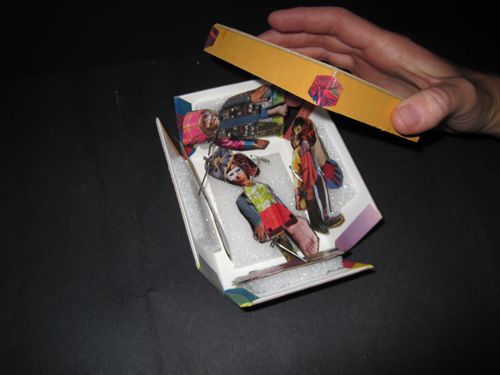
- Each inner box is stamped with "property of" and a series of natural history or art museums,
with the museum names crossed out (as if they no longer "own" the contents), such as "property of
Smithsonian." We wanted to raise questions about ownership and the right to display artifacts (or peoples).
-
A sorting system for the feathers calls for them to be categorized and displayed, but the lack of information and the fact that the sorting boxes are blocked makes this impossible. The manufactured quality of the feathers, such as their machine-dyed brightness, highlights the tension between the simulated contexts of display and the institution's claims at authenticity and certainty. Further, such claims are destabilized by Tuhiwai Smith's quote in the sorting tray about trading the Other as a contrived means of knowledge construction produced for economic and cultural gain by the West. In this box, we wanted to create a counternarrative for ways the viewer might derive pleasure when encountering the topic of "indigenous peoples" in an exhibition setting. Instead of being the explorer who masters the worlds of the Other through gaining essential knowledge about them, the viewer of our artist book gains pleasure from destabilizing such Western logic, and asking questions that acknowledge both the harm done and the survival and resistance of indigenous peoples to this harm.
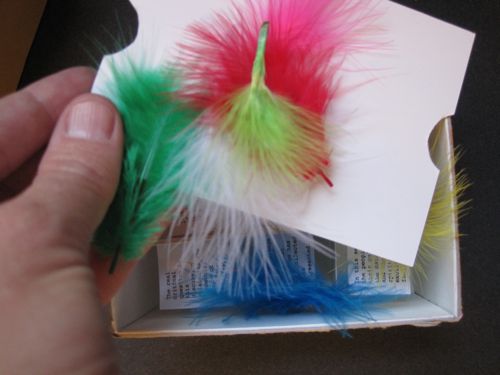
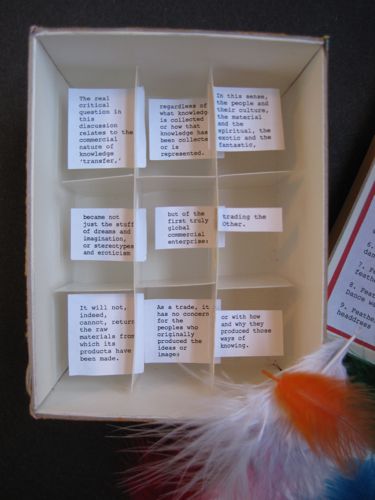 Implications
Implications
How can Western ethnographic display occur with consciousness of its tendency to essentialize, romanticize, and mythologize non-dominant cultures? How can museums, non-fiction guides, school curriculum, and even tourism borrow from poststructural and postmodern approaches to de-center the assumed authority of both writer and artifact? With our artist book, we both used an arts-based method for analyzing the data of the children's books and suggested through heuristic example arts-based ways that teachers might work with students to destabilize historical and cultural constructions. As readers encounter texts like the Eyewitness series and museum exhibitions displaying various cultures, we ask them to emancipate themselves from passive consumption (Ranciere, 2009). Instead, an active way of looking involves inviting destabilization, feeling comfortable with not knowing and even resisting the "authority" of the text, and raising key questions about subjectivity and the construction of narratives in both writer and viewer.
Initial topics for discussion with young people might include: 1)
The subjectivity of the researcher. How does the text explicitly and implicitly situate the
writer in relation to the subject matter? What do we know about the researcher? What are the purposes
for the writing? Who benefits from the writing? Who does not?). 2) The use of multiple voices.
How does the display include polyphony through choice of artifact and interpretation? When are these
multiple perspectives included? When are they not? How do the perspectives presented affect what we
know? 3) The use of experiences versus objects. How does the display portray or include people's
performed actions (such as stories, rites, ceremonies, behaviors), in addition to showing their objects?
How does the use of performances change our understanding of the story told? 4) The construction of
narrative. How does the display fragment the story by period, location, or theme? Who made those
choices? How does that affect our understanding? 5) The role of viewer inquiry. How does the
display encourage--or shut down--further scholarship, dialog, and action? How does viewer-initiated
action affect the stories told, and the power held by the owners of the display?
For example, young people in an instructional unit on "first Americans" might conduct research about the identities of the Eyewitness writers, why they are interested in the culture they wrote about, how they obtained information and artifacts, what these authors are still researching, and so forth. The young people could write self-reflections, in which they answer these same questions about themselves as researchers. They could find photographs of the writers as well as contemporary indigenous researchers in action. This would position and de-center the authority of the "objective" writer and demonstrate the open, living nature of historical scholarship, as well as teach young people to take ethical stances when conducting their own research.
Young people could uncover counternarratives absent in the
Eyewitness books (or other school curricula). In terms of artifact selection, they might find
artifacts or performances that the Eyewitness books did not include, such as political
cartoons on both sides of the Native American assimilation/separatism debate, or creative writing by
indigenous peoples about their loss in relation to colonialism and imperialism. In addition, young
people could create new textual labels and interpretations, opposing those in the text, inviting readers
to agree with one, or both, or neither. They might write new introductory text for a theme that includes polyvocal or situated text, or re-theme the book according to the indigenous people's voices that they read through their new research. These counternarratives would help young people learn the importance of multiple points of view around the historical record, as well as its limited, incomplete, and always changing qualities (Postlewait, 1991).
Third, young people might search out elements of the repertoire (performed behaviors) to contribute to the enhancement of meaning and understanding (Taylor, 2003). They could find fragments of stories or songs, as well as multiple photographs of dances and dramas rather than a single, frozen moment. By its nature, the repertoire encourages positionality and polyphony; it changes through retelling based on the historical and material circumstances surrounding it. Perhaps young people could research multiple tellings of a particular story along with a description of how and why those tellings changed. Once young people have gathered such primary sources, they can confront the "tyranny of the page" (its flat, rectangular, directional qualities) that often prevents the inclusion of many "ephemeral" or performed pieces of the repertoire. Young people might consider making three-dimensional objects like our artist book, or the creation of a DVD or CD to address such limitations.
Fourth, young people might use artist book methods in order to reconsider how to structure one's understanding of another culture. We are interested in ways to create interconnectivity rather than fragmentation, such as the interaction and hybridity between geographic areas, time periods, and aspects of culture. Young people might consider deconstructing the elements of a book: its spine, front and back covers, directionality for reading, as well as other objects that might be "read" like we read books. We used boxes as our structural base and then played with their elements to raise questions. Although some division is useful for tracking the multiple elements covered by in the Eyewitness books, its structural, thematic divisions are grounded in Western science's pursuit of cataloging people in a narrative of progress that structures our gaze and ways of knowing ourselves and others. To counteract this fragmentation, young people could highlight the interrelationships of people in their writing and pose questions to the reader that ask them to make connections between and across topics. Or, young people could learn (in a variety of settings) the skills of an arts-based method that might increase their critical thinking about the impact of people's interconnectivity, and their ability to articulate such impacts beyond the limits of two-dimensional paper.
Finally, young people might consider the ethical dilemmas of research in their own writing process. Too often students are asked to create a sugar-cube diorama of a California mission or a craft stick teepee and then write a descriptive "report" about it. When teachers discuss what a "reliable" internet source is, they should include author context, such as if the scholarship discloses how information was gathered, as well as if the source makes the historical record sound complete or in process. From here, the teacher could include discussion questions or activities that prompt young people to perform an analysis of multiple sources, pay attention to and highlight gaps or ambiguities in the archive, as well as reflect on how interpretive text is written and how displays affect our understanding. These are not easy questions to ask or processes to conduct with young people. As researchers, artists and educators, we are not claiming that a young person conducting one research project using some of these strategies will accomplish transformative destabilizations of oppressive, objectifying ways of understanding cultural difference. Rather, we make suggestions for a life-long learning trajectory based on our own continually recursive process of decolonizing our own research methods.
In future research, we are interested in learning from a variety of arts-based strategies that teachers have used with young people to resist essentializing, romanticizing, mythologizing, and consigning the cultures to history. Such aesthetic pedagogies shift the curricular focus from a transfer of information to critical, constructivist learning and inquiry: how and why do encounters among people create frictions and instabilities? Why are these tensions important to our constructions of knowledge? How can we rupture the trading of the Other, so that (as the girl in Nanny's Travels suggests in the beginning of the article) there is more to a museum (or book, or tour, or...) than this.
References
About us/Children's books. dk.com. Retrieved April 15, 2005 from http://us.dk.com/static/cs/us/11/about/children.html
Baquedano, E. (2005). Eyewitness Aztec, Inca & Maya. New York: Dorling Kindersley.
Barone, T. (2001). Touching eternity: The enduring outcomes of teaching. New York: Teachers College Press.
Barthes, R. (1977). Image, music, text. Trans. Stephen Heath. New York: Hill and Wang.
Baudrillard, J. (1994). Simulacra and simulation. Trans. S. Faria Glaser. Ann Arbor: University of Michigan Press.
Benjamin, W. (1939/2003). The work of art in the age of mechanical reproduction. Trans. E. Jephcott et. al. In H. Eiland & M. W. Jennings (Eds.), Walter Benjamin: Selected writings vol. 4 1938-1940 (pp. 251-283). Cambridge, MA: The Belknap Press of Harvard University Press.
Bennett, T. (2006). Difference and the logic of culture. In I. Karp, C. Kratz, L. Szwaja, & T. Ybarra-Frausto (Eds.), Museum frictions: Public cultures/global transformations (pp. 46-69). Durham: Duke University Press.
Bigelow, B & Peterson, B (1994). Students as textbook detectives. Rethinking our classrooms: Teaching for equity and justice, vol. 1, (pp. 158-159).
Bodman, S. (2008). The quiet democracy of the contemporary artist's book (or, why do artists make books?). Books That Fly Conference, University of Brighton, 5th July, 2008.
Cahnmann, M. & Siegesmund, R. (2008). Arts-based research in education: Foundations for practice. New York: Routledge.
Chappell, D. (2010). Children under construction: Critical essays on play as curriculum. New York: Peter Lang.
Chappell, S. (May 2009). A rough handshake or an illness: Teaching and learning on the border as felt through art-making. Journal of Curriculum and Pedagogy.
Clifford, J. (1999). Museums as contact zones. In D. Boswell & J. Evans (Eds.), Representing the nation: A reader. New York: Routledge Press.
Company overview. dk.com. Retrieved April 15, 2005 from http://us.dk.com/static/cs/us/11/about/company.html
Comte, A. (1957). A general view of positivism. Trans. J. H Bridges. New York: R Speller.
Deloria, P. (1998). Playing Indian. New Haven, CT: Yale University Press.
DK Publisher. (2005). A life like mine. New York: DK Children.
Freedman, K. (2003). Teaching visual culture: Curriculum, aesthetics, and the social life of art. New York: Teachers College Press.
Fusco, C. & Heredia, P. (1993). The couple in the cage: A Guatinaui odyssey. New York: Third World Newsreel.
Gomez-Pena, G. (2005). Ethno-techno: Writings on performance, activism, and pedagogy. New York: Routledge.
Hooper-Greenhill, E. (1992). Museums and the shaping of knowledge. New York: Routledge.
JanMohamed, A. (1985). The economy of Manichean allegory: The function of racial difference in colonialist literature. Critical Inquiry, 12(1), 59-87.
Judd, D., & Hubert, R. (1997). The book, the museum, and public art. SubStance, 26(1), 69-92.
Kindersley, A. & Kindersley, B. (1995). Children just like me. New York: DK Children.
Kirshenblatt-Gimblett, B. (1998). Destination culture: Tourism, museums, and heritage. Berkeley: University of California Press.
Kirshenblatt-Gimblett, B. (2006). Exhibitionary complexes. In I. Karp, C. Kratz, L. Szwaja, & T. Ybarra-Frausto (Eds.), Museum frictions: Public cultures/global transformations, (pp. 35-45). Durham: Duke University Press.
Knowles, J. G. & Cole, A. (2007). Handbook of the arts in qualitative research: Perspectives, methodologies, examples, and issues. Thousand Oaks, CA: Sage Publications.
Kratz, C. & Karp, I. (2006). Introduction. In I. Karp, C. Kratz, L. Szwaja, & T. Ybarra-Frausto (Eds.), Museum frictions: Public cultures/global transformations, (pp. 1-34). Durham: Duke University Press.
Ladson-Billings, G.J. & Tate, W.F. (1994). Toward a theory of critical race theory in education. Teachers College Record, 97, 47-68.
Lawrence, D. H. (1924). Studies in classic American literature. London: Martin Secker.
Mulvey, L. (1975). Visual pleasure and narrative cinema. Screen, 16(3): 6-18
Murdoch, D. (2005). Eyewitness North American Indian. New York: Dorling Kindersley.
Pierce, Charles S. (c. 1885). One, two, three: Fundamental categories of thought and nature. In Collected Papers, vol. I.
Postlewait, T. (1991). Historiography and the theatrical event: A primer with twelve cruxes. Theatre Journal, 43(2), 157-178.
Ranciere, J. (2009). The emancipated spectator, Trans. G. Elliot. London: Verso Books.
Rothenberg, J. & Clay, S. (2000). A book of the book: Some works & projections about the book and writing. New York: Granary Books.
Smith, K. (2000). The book as physical object. In J. Rothenberg & S. Clay (Eds.), A book of the book: Some works & projections about the book and writing, (54-70). New York: Granary Books.
Springgay, S. (2008). Body knowledge and curriculum: Pedagogies of touch in youth and visual culture. New York: Peter Lang.
Starbuck, H. M. (2003). Clashing and converging: Effects of the internet on the correspondence art network. University of Texas at Austin. Retrieved June 15, 2010 from http://www.mailartist.com/honoria/research2003/methods.htm
Szwaja, L. & Ybarra-Frausto, T. (2006). Forward. In I. Karp, C. Kratz, L. Szwaja, & T. Ybarra-Frausto (Eds.), Museum frictions: Public cultures/global transformations, (pp. xi-xiv). Durham: Duke University Press.
Taussig, M. (1987) Shamanism, colonialism, and the wild man: a study in terror and healing. Chicago: University of Chicago Press.
Taylor, D. (2003). The archive and the repertoire: Performing cultural memory in the Americas. Durham: Duke University Press.
Tuhiwai Smith, L. (1999). Decolonizing methodologies: Research and indigenous peoples. London: Zed Books.
Vaughn, K. (2005). Pieced together: Collage as an artist's method for interdisciplinary research. International Journal of Qualitative Methods, 4(1).
Walker, K. (1997). Slavery! Slavery! Presenting a GRAND and LIFELIKE panoramic journey into picturesque south slavery of "Life at 'ol' Virginny's hole' (sketches from plantation life)" See the peculiar institution as never before! All cut from black paper by the able hand of Kara Elizabeth Walker an emancipated Negress and leader of her cause 1997. Collections of Peter Norton and Eileen Norton, Santa Monica, CA.
Woodhead, P. & Stansfield, G. (1994). Key guide to information sources in museum studies, 2nd ed. London: Mansell Publishing.
About the Authors
Sharon Chappell is in the Department of Elementary and Bilingual Education at California State University Fullerton. She specializes in issues of diversity, curriculum, language learning, and arts-based research. She is trying to teach her four-year old daughter decolonizing methodologies.
Drew Chappell is in the Department of Theatre and Dance at California State University Fullerton. He is a performance studies scholar with interests in play, globalization, and constructions of young audiences. He is also an award-winning playwright whose work deals with issues that affect both children and adults.
|






 In the second box is a collection of feathers, and underneath these is a sorting tray where the feathers
may be placed. At the base of each box in the sorter is more text inspired by Tuhiwai Smith's critique of
the West's economic and cultural dependence on trading the Other as a means of knowledge formation and
distribution (p. 89). The lid contains a list of feathers and their historical function, as expressed in
North American Indian and Aztec, Inca and Maya.
In the second box is a collection of feathers, and underneath these is a sorting tray where the feathers
may be placed. At the base of each box in the sorter is more text inspired by Tuhiwai Smith's critique of
the West's economic and cultural dependence on trading the Other as a means of knowledge formation and
distribution (p. 89). The lid contains a list of feathers and their historical function, as expressed in
North American Indian and Aztec, Inca and Maya.



 We hope these encounters call attention to the effects of an ongoing cataloguing of native peoples, in a way consistent with Kirshenblatt-Gimblett's (1998) appreciation of the performances she witnessed at the 1990 Los Angeles Festival: "A mode of reception in which confusion is pleasurable opens up possibilities for the exhibition of African art, while keeping alive the issue of what can and cannot be shown or known" (p. 11). In our implications, we expand on how young people themselves can destabilize the constructed expertise of the curatorial voice in order to understand the impact of Western collection from multiple perspectives (particularly those of indigenous people affected by such "research").
We hope these encounters call attention to the effects of an ongoing cataloguing of native peoples, in a way consistent with Kirshenblatt-Gimblett's (1998) appreciation of the performances she witnessed at the 1990 Los Angeles Festival: "A mode of reception in which confusion is pleasurable opens up possibilities for the exhibition of African art, while keeping alive the issue of what can and cannot be shown or known" (p. 11). In our implications, we expand on how young people themselves can destabilize the constructed expertise of the curatorial voice in order to understand the impact of Western collection from multiple perspectives (particularly those of indigenous people affected by such "research").





